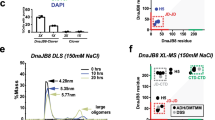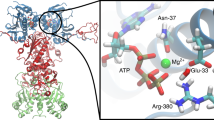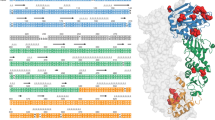Abstract
Heat-shock protein 90 (Hsp90) is an ATP-dependent molecular chaperone that associates dynamically with various co-chaperones during its chaperone cycle. Here we analyzed the role of the activating co-chaperone Aha1 in the progression of the yeast Hsp90 chaperone cycle and identified a critical ternary Hsp90 complex containing the co-chaperones Aha1 and Cpr6. Aha1 accelerates the intrinsically slow conformational transitions of Hsp90 to an N-terminally associated state but does not fully close the nucleotide-binding pocket yet. Cpr6 increases the affinity between Aha1 and Hsp90 and further stimulates the Hsp90 ATPase activity. Synergistically, Aha1 and Cpr6 displace the inhibitory co-chaperone Sti1 from Hsp90. To complete the cycle, Aha1 is released by the co-chaperone p23. Thus, at distinct steps during the Hsp90 chaperone cycle, co-chaperones selectively trap statistically distributed Hsp90 conformers and thus turn Hsp90 into a deterministic machine.
This is a preview of subscription content, access via your institution
Access options
Subscribe to this journal
Receive 12 print issues and online access
$189.00 per year
only $15.75 per issue
Buy this article
- Purchase on Springer Link
- Instant access to full article PDF
Prices may be subject to local taxes which are calculated during checkout





Similar content being viewed by others
References
Zhao, R. et al. Navigating the chaperone network: an integrative map of physical and genetic interactions mediated by the hsp90 chaperone. Cell 120, 715–727 (2005).
Young, J.C., Moarefi, I. & Hartl, F.U. Hsp90: a specialized but essential protein-folding tool. J. Cell Biol. 154, 267–273 (2001).
Richter, K., Haslbeck, M. & Buchner, J. The heat shock response: life on the verge of death. Mol. Cell 40, 253–266 (2010).
Taipale, M., Jarosz, D.F. & Lindquist, S. HSP90 at the hub of protein homeostasis: emerging mechanistic insights. Nat. Rev. Mol. Cell Biol. 11, 515–528 (2010).
Picard, D. Heat-shock protein 90, a chaperone for folding and regulation. Cell. Mol. Life Sci. 59, 1640–1648 (2002).
McClellan, A.J. et al. Diverse cellular functions of the Hsp90 molecular chaperone uncovered using systems approaches. Cell 131, 121–135 (2007).
Tsutsumi, S. et al. Hsp90 charged-linker truncation reverses the functional consequences of weakened hydrophobic contacts in the N domain. Nat. Struct. Mol. Biol. 16, 1141–1147 (2009).
Prodromou, C. The 'active life' of Hsp90 complexes. Biochim. Biophys. Acta 1823, 614–623 (2012).
Ali, M.M. et al. Crystal structure of an Hsp90-nucleotide-p23/Sba1 closed chaperone complex. Nature 440, 1013–1017 (2006).
Hessling, M., Richter, K. & Buchner, J. Dissection of the ATP-induced conformational cycle of the molecular chaperone Hsp90. Nat. Struct. Mol. Biol. 16, 287–293 (2009).
Prodromou, C. et al. The ATPase cycle of Hsp90 drives a molecular 'clamp' via transient dimerization of the N-terminal domains. EMBO J. 19, 4383–4392 (2000).
Shiau, A.K., Harris, S.F., Southworth, D.R. & Agard, D.A. Structural Analysis of E. coli hsp90 reveals dramatic nucleotide-dependent conformational rearrangements. Cell 127, 329–340 (2006).
Pullen, L. & Bolon, D.N. Enforced N-domain proximity stimulates Hsp90 ATPase activity and is compatible with function in vivo. J. Biol. Chem. 286, 11091–11098 (2011).
Southworth, D.R. & Agard, D.A. Species-dependent ensembles of conserved conformational states define the Hsp90 chaperone ATPase cycle. Mol. Cell 32, 631–640 (2008).
Ratzke, C., Berkemeier, F. & Hugel, T. Heat shock protein 90's mechanochemical cycle is dominated by thermal fluctuations. Proc. Natl. Acad. Sci. USA 109, 161–166 (2012).
Mayer, M.P., Nikolay, R. & Bukau, B. Aha, another regulator for hsp90 chaperones. Mol. Cell 10, 1255–1256 (2002).
Richter, K., Muschler, P., Hainzl, O., Reinstein, J. & Buchner, J. Sti1 is a non-competitive inhibitor of the Hsp90 ATPase. Binding prevents the N-terminal dimerization reaction during the ATPase cycle. J. Biol. Chem. 278, 10328–10333 (2003).
Boulon, S. et al. HSP90 and its R2TP/Prefoldin-like cochaperone are involved in the cytoplasmic assembly of RNA polymerase II. Mol. Cell 39, 912–924 (2010).
Li, J., Soroka, J. & Buchner, J. The Hsp90 chaperone machinery: conformational dynamics and regulation by co-chaperones. Biochim. Biophys. Acta 1823, 624–635 (2012).
Kosano, H., Stensgard, B., Charlesworth, M.C., McMahon, N. & Toft, D. The assembly of progesterone receptor-hsp90 complexes using purified proteins. J. Biol. Chem. 273, 32973–32979 (1998).
Smith, D.F. Dynamics of heat shock protein 90-progesterone receptor binding and the disactivation loop model for steroid receptor complexes. Mol. Endocrinol. 7, 1418–1429 (1993).
Freeman, B.C., Felts, S.J., Toft, D.O. & Yamamoto, K.R. The p23 molecular chaperones act at a late step in intracellular receptor action to differentially affect ligand efficacies. Genes Dev. 14, 422–434 (2000).
Chen, S. & Smith, D.F. Hop as an adaptor in the heat shock protein 70 (Hsp70) and hsp90 chaperone machinery. J. Biol. Chem. 273, 35194–35200 (1998).
Li, J., Richter, K. & Buchner, J. Mixed Hsp90-cochaperone complexes are important for the progression of the reaction cycle. Nat. Struct. Mol. Biol. 18, 61–66 (2011).
Ebong, I.O. et al. Heterogeneity and dynamics in the assembly of the heat shock protein 90 chaperone complexes. Proc. Natl. Acad. Sci. USA 108, 17939–17944 (2011).
Hildenbrand, Z.L. et al. Hsp90 can accommodate the simultaneous binding of the FKBP52 and HOP proteins. Oncotarget 2, 43–58 (2011).
Retzlaff, M. et al. Asymmetric activation of the hsp90 dimer by its cochaperone aha1. Mol. Cell 37, 344–354 (2010).
Mayor, A., Martinon, F., De Smedt, T., Petrilli, V. & Tschopp, J. A crucial function of SGT1 and HSP90 in inflammasome activity links mammalian and plant innate immune responses. Nat. Immunol. 8, 497–503 (2007).
Panaretou, B. et al. Activation of the ATPase activity of hsp90 by the stress-regulated cochaperone aha1. Mol. Cell 10, 1307–1318 (2002).
Koulov, A.V. et al. Biological and structural basis for Aha1 regulation of Hsp90 ATPase activity in maintaining proteostasis in the human disease cystic fibrosis. Mol. Biol. Cell 21, 871–884 (2010).
Harst, A., Lin, H. & Obermann, W.M. Aha1 competes with Hop, p50 and p23 for binding to the molecular chaperone Hsp90 and contributes to kinase and hormone receptor activation. Biochem. J. 387, 789–796 (2005).
Mayr, C., Richter, K., Lilie, H. & Buchner, J. Cpr6 and Cpr7, two closely related Hsp90-associated immunophilins from Saccharomyces cerevisiae, differ in their functional properties. J. Biol. Chem. 275, 34140–34146 (2000).
Duina, A.A., Chang, H.C., Marsh, J.A., Lindquist, S. & Gaber, R.F. A cyclophilin function in Hsp90-dependent signal transduction. Science 274, 1713–1715 (1996).
Richter, K., Muschler, P., Hainzl, O. & Buchner, J. Coordinated ATP hydrolysis by the Hsp90 dimer. J. Biol. Chem. 276, 33689–33696 (2001).
Weikl, T. et al. C-terminal regions of Hsp90 are important for trapping the nucleotide during the ATPase cycle. J. Mol. Biol. 303, 583–592 (2000).
Johnson, J.L. & Toft, D.O. Binding of p23 and hsp90 during assembly with the progesterone receptor. Mol. Endocrinol. 9, 670–678 (1995).
Johnson, J., Corbisier, R., Stensgard, B. & Toft, D. The involvement of p23, hsp90, and immunophilins in the assembly of progesterone receptor complexes. J. Steroid Biochem. Mol. Biol. 56, 31–37 (1996).
Zuehlke, A.D. & Johnson, J.L. Chaperoning the chaperone: a role for the co-chaperone Cpr7 in modulating Hsp90 function in Saccharomyces cerevisiae. Genetics 191, 805–814 (2012).
Richter, K. et al. Conserved conformational changes in the ATPase cycle of human Hsp90. J. Biol. Chem. 283, 17757–17765 (2008).
McLaughlin, S.H., Smith, H.W. & Jackson, S.E. Stimulation of the weak ATPase activity of human hsp90 by a client protein. J. Mol. Biol. 315, 787–798 (2002).
McLaughlin, S.H. et al. The co-chaperone p23 arrests the Hsp90 ATPase cycle to trap client proteins. J. Mol. Biol. 356, 746–758 (2006).
Hagn, F. et al. Structural analysis of the interaction between Hsp90 and the tumor suppressor protein p53. Nat. Struct. Mol. Biol. 18, 1086–1093 (2011).
Street, T.O., Lavery, L.A. & Agard, D.A. Substrate binding drives large-scale conformational changes in the Hsp90 molecular chaperone. Mol. Cell 42, 96–105 (2011).
Park, S.J., Borin, B.N., Martinez-Yamout, M.A. & Dyson, H.J. The client protein p53 adopts a molten globule-like state in the presence of Hsp90. Nat. Struct. Mol. Biol. 18, 537–541 (2011).
Buchner, J., Weikl, T., Bugl, H., Pirkl, F. & Bose, S. Purification of Hsp90 partner proteins Hop/p60, p23, and FKBP52. Methods Enzymol. 290, 418–429 (1998).
Ali, J.A., Jackson, A.P., Howells, A.J. & Maxwell, A. The 43-kilodalton N-terminal fragment of the DNA gyrase B protein hydrolyzes ATP and binds coumarin drugs. Biochemistry 32, 2717–2724 (1993).
Winzeler, E.A. et al. Functional characterization of the S. cerevisiae genome by gene deletion and parallel analysis. Science 285, 901–906 (1999).
Kroe, R.R. & Laue, T.M. NUTS and BOLTS: applications of fluorescence-detected sedimentation. Anal. Biochem. 390, 1–13 (2009).
Laue, T.M. & Stafford, W.F. III. Modern applications of analytical ultracentrifugation. Annu. Rev. Biophys. Biomol. Struct. 28, 75–100 (1999).
Acknowledgements
We thank J. Soroka (Center for Integrated Protein Science, Department Chemie, Technische Universität München, München, Germany) who provided labeled Hsp90, Aha1 and purified Hsp90 for the subunit-exchange experiment. J.B. and K.R. were supported by the Deutsche Forschungsgemeinschaft (grants SFB1035 A3 and RI1873/1-2, respectively) and by the Fonds der chemischen Industrie. J.B. was also supported by the German Bundesministerium für Bildung und Forschung (Federal Ministry of Education and Research) as part of ProNet-T3. J.R. was supported by the Max Planck Society.
Author information
Authors and Affiliations
Contributions
J.L. designed and performed experiments, evaluated the results and wrote the manuscript. K.R. conducted aUC experiments and contributed to writing the manuscript. J.R. conducted and analyzed stopped-flow experiments and contributed to writing the manuscript. J.B. designed and supervised experiments and wrote the manuscript.
Corresponding author
Ethics declarations
Competing interests
The authors declare no competing financial interests.
Supplementary information
Supplementary Text and Figures
Supplementary Figures 1–5 (PDF 1459 kb)
Rights and permissions
About this article
Cite this article
Li, J., Richter, K., Reinstein, J. et al. Integration of the accelerator Aha1 in the Hsp90 co-chaperone cycle. Nat Struct Mol Biol 20, 326–331 (2013). https://doi.org/10.1038/nsmb.2502
Received:
Accepted:
Published:
Issue Date:
DOI: https://doi.org/10.1038/nsmb.2502
This article is cited by
-
Hsp90 co-chaperones, FKBP52 and Aha1, promote tau pathogenesis in aged wild-type mice
Acta Neuropathologica Communications (2021)
-
AHA1 upregulates IDH1 and metabolic activity to promote growth and metastasis and predicts prognosis in osteosarcoma
Signal Transduction and Targeted Therapy (2021)
-
The Hsp70–Hsp90 go-between Hop/Stip1/Sti1 is a proteostatic switch and may be a drug target in cancer and neurodegeneration
Cellular and Molecular Life Sciences (2021)
-
A methylated lysine is a switch point for conformational communication in the chaperone Hsp90
Nature Communications (2020)
-
The conserved NxNNWHW motif in Aha-type co-chaperones modulates the kinetics of Hsp90 ATPase stimulation
Nature Communications (2019)



